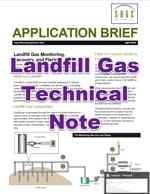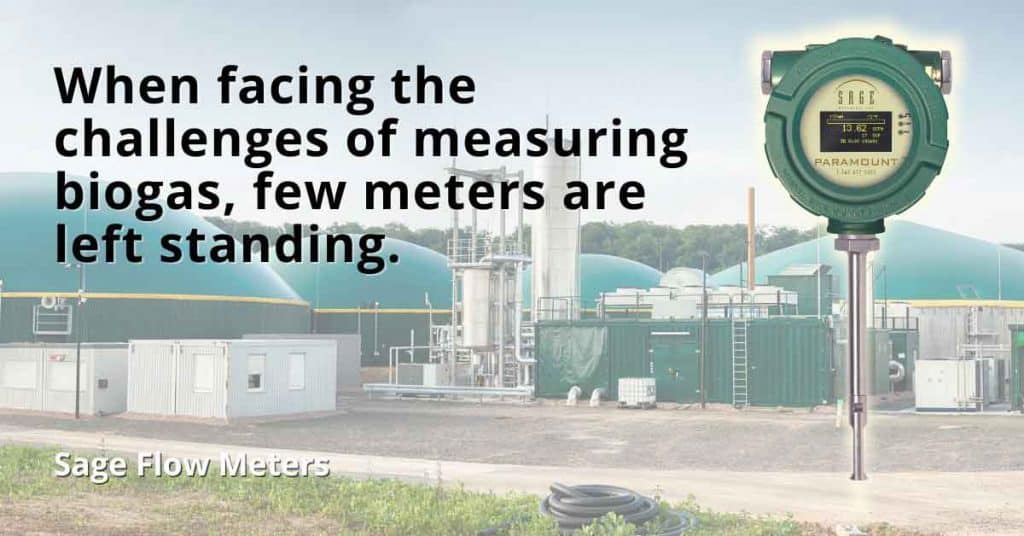The thermal mass flow meter makes an excellent biogas flow meter. They provide an accurate and dependable biogas measurement and offer distinct advantages over alternative flow meters. In any of the following biogas applications, the user should consider the moisture content of the gas.
How do you measure biogas?
Biogas is a naturally occurring gas produced from the decomposition of organic material. The gas consists of a mixture of methane and carbon dioxide with small amounts of other gases, including hydrogen sulfide, nitrogen, and trace amounts of other gases. Composition can range from 35% methane, 65% carbon dioxide to 70% methane, 30% carbon dioxide. Biogas can also be wet and dirty. Sources of biogas include digesters in wastewater treatment plants, landfill operations, and waste-to-energy plants.
Wastewater Treatment Plant
The incoming sewage containing organic solids is separated from the liquid at a wastewater treatment plant. This sludge goes through various treatments, including anaerobic digestion, typical in extensive wastewater treatment facilities that commonly use anaerobic digesters. In the anaerobic digester, the microorganisms decompose the waste without oxygen, reducing the amount of sludge and producing biogas. Biogas composition from a digester will be approximately 60-65% methane, with 35-40% carbon dioxide. A digester can produce almost enough biogas to meet the plant’s energy demands.
Read more information on wastewater digester gas in the Sage technical brief, Wastewater Digester Gas at Wastewater Treatment Plant.
Landfill Gas

The decomposition of the organic material primarily produces landfill gas (LFG) in municipal solid waste. The organic material is typically food scraps, waste paper, and cardboard. A collection system includes extraction wells and a series of collection manifolds that connect to the main manifold and a blower. There are various options for the disposal of the LFG. A small landfill may flare the LFG on the property. More extensive landfill operations may feed the LFG to a boiler or engine to produce energy. Sometimes, the LFG can be treated and fed into a natural gas pipeline. The maximum flow of LFG occurs after five to seven years and will then decline. The methane and carbon dioxide ratio will also change over the landfill’s life.
More information about the measurement of landfill gas is available in the Sage application brief, Landfill Gas Monitoring, or Recovery, and Flaring.
What is a waste-to-energy plant?
The term “waste-to-energy plants” refers to facilities taking organic material and converting it to biogas. The organic material may be agricultural waste such as livestock manure and byproducts from food and vegetable processing. A large covered lagoon is frequently used rather than a separate digester vessel.
How does a biogas plant work?
Biogas Flow Meter

Accurately measuring biogas flow rates can be challenging. Much depends on the source of the biogas, and the user should consider application-specific issues when using thermal mass flow meters. Advantages of thermal mass flow meters when measuring biogas include:
-
- Mass flow measurement without the need for pressure and temperature correction
- Digester gas flow may be at low velocities. The thermal mass flow meter has excellent low-velocity sensitivity, while other bio gas flow meter types do not accurately measure low flow rates.
- Digester gas is often dirty leading to the need to maintain flow meters. Thermal mass flow meters can include a retraction device permitting the removal of the probe for periodic cleaning.
Considerations
Digester gas can be wet and contain condensed moisture. Condensed moisture can cause spiking in a thermal mass flow meter. Often a user can successfully remove the condensed moisture can successfully be removed with the use of a moisture drop-out chamber. This vessel provides a reduction in velocity and change in direction, causing moisture droplets to separate from the gas stream.
The thermal mass flow meter makes an accurate and reliable biogas flowmeter, providing many advantages over alternative measurement technologies.
See Biogas Correction Factors for Biogas Variation From Original Calibration


